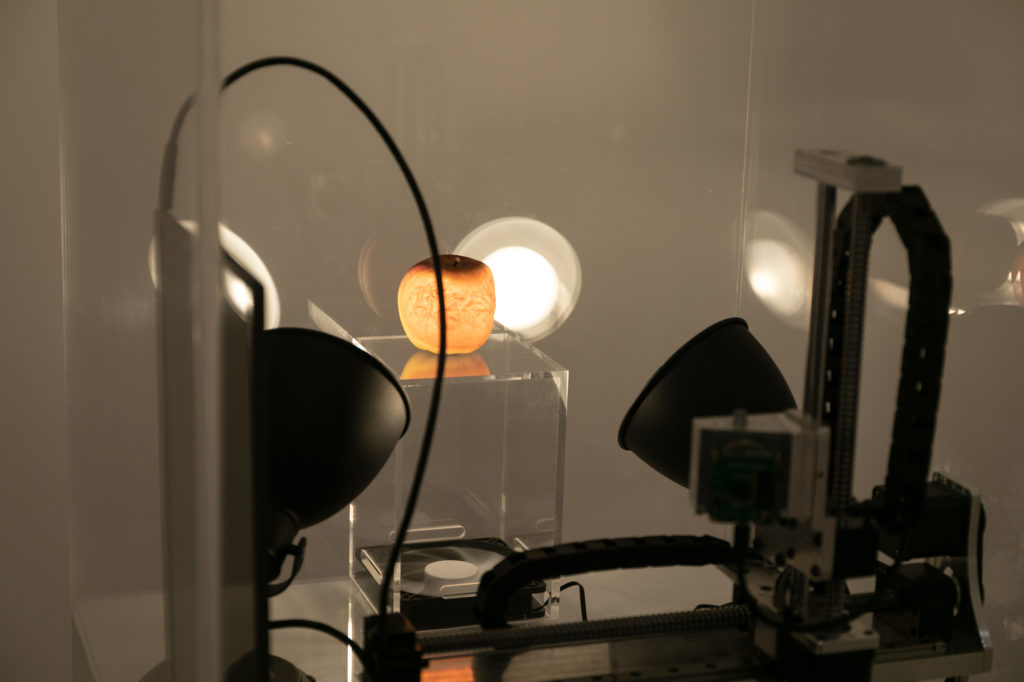Artists are often thought to be transcendent figures, at the centre of their creative webs, pulling the strings, expressing themselves, changing the world. Drawing on approaches from artificial life, brain science, robotics, radio astronomy, and earth-system science, Simon Ingram overturns this model, notionally displacing, even marginalising ‘the artist’. For many years, the Auckland artist has been making paintings by mathematical, mechanical, and electronic means. The gridded compositions of his early Automata Paintings were arrived at not by intuition but using simple algorithms. Later, he developed painting machines that generate novel compositions on the fly in response to low-frequency radio waves, whose changes in amplitude index cosmic activity.
Sometimes Ingram exhibits his machines at work; sometimes he just shows the finished paintings, inviting a different kind of appreciation. The machines use traditional tools (a brush applying oil paint), and the programs guarantee a stylistic coherence and logic. The paintings look modernist; sometimes more geometric, sometimes more expressionist. Aesthetics is important to Ingram. For instance, his ‘radio painting’ Matotchkinchar (2011) recalls elegant filigrees of lace. Evolving from randomness above to regimented vertical lines below, it prompts us to speculate on what its seductive beauty might indicate about the input data and about the program itself.
In 2018, Ingram stepped back into the picture. He said: ‘After looking upwards to the cosmos, I want to return to the question of people and painting, but in a way that doesn't favour the conscious mind. Instead, I focus on people as assemblages of physical, energetic elements—part of nature and the cosmos. To borrow from Kazimir Malevich: I paint energy, not the soul.’
For his painting-performance project, Monadic Device, at Sydney Contemporary that year, Ingram collaborated with John Paul-Pochin to get his painting machine to respond to his electrical activities in his brain input via an EEG headset, as he read Stanisław Lem’s Solaris, wrote emails, chatted with passers-by, made phone calls, drank coffee, etcetera. The machine was programmed to mark out lines that wandered around the canvas, avoiding paths previously traced, and tunnelling under or glancing off lines it encountered. The artist’s beta waves determined the length of lines, his alpha waves whether they turned left or right. To complicate matters, Ingram used a Wacom tablet to draw directly into the machine’s interface. So, the resulting paintings scrambled drawing by hand (with intention) and drawing by brain (without).
Recently, Ingram initiated Terrestrial Assemblages, an art-science group concerned to foster awareness of natural systems. With Pochin, he developed Earth Models—a series of evolving models, presented on unboxed computers, showing the effects of regenerative agricultural approaches. As the models evolve, they share data—output from one becoming an input for another. With Robert Spite, Ingram devised a still life, where a hyperspectral camera (which registers light outside the visible spectrum) observes organic matter decay. This work nods both to the Dutch vanitas still-life tradition and to the visualisation of invisible energies in Ingram’s Radio Paintings.
The Algorithmic Impulse surveys Ingram’s work since 1996 and unveils Terrestrial Assemblages’ new projects. On the show's opening weekend, Ingram will don the EEG headset to create new paintings using Monadic Device. Throughout the show, others will also have the opportunity. While some will be invited by Ingram (including scientists, artists, curators, and art writers), members of the public can also apply to participate. Paintings will accumulate in the space over the course of the show. Encompassing the interplay of artist, technology, world, and cosmos—culture and nature—The Algorithmic Impulse demonstrates the diversity of Ingram’s ‘assemblages’.
This show has been supported by University of Auckland.














































































